Six major projects compete for the market, and the future financial landscape awaits!
Author: stablewatch & Castle_Labs
Translation: Deep Tide TechFlow
Summary
Stablecoins are dominating the headlines in 2025. This raises the question of which blockchain network will support and promote this asset class. As tokenized dollars continue to gain acceptance and regulation, six upcoming Layer 1 blockchains are seeking to join the competition, vying with established stablecoin networks like Ethereum, Tron, Solana, and Base.
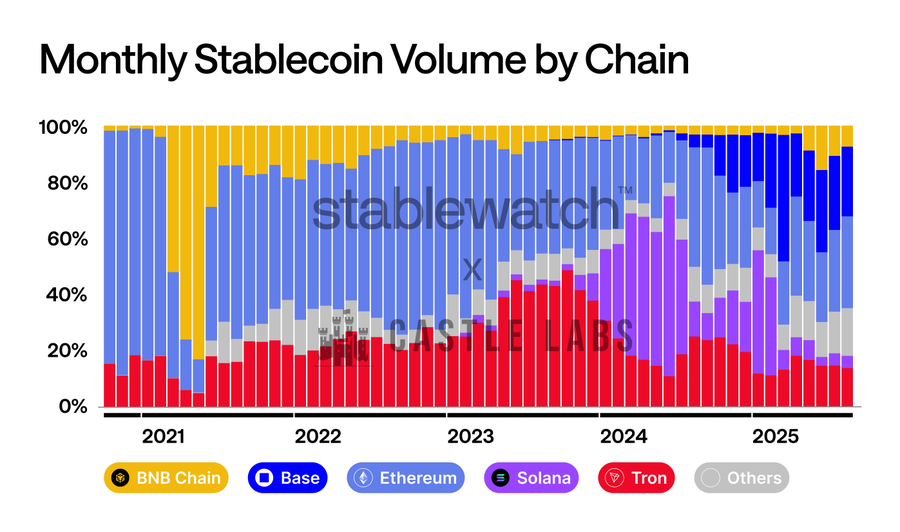
These blockchains include Plasma, Codex, 1Money, Arc, Stable, and Monad, which recently acquired Portal Labs, each with different designs and visions to penetrate this thriving industry.
This comparative analysis strips away marketing noise and examines these networks from the following aspects: architectural innovation, consensus mechanisms, performance metrics, specialized features, and development momentum. We will use these findings to assess their positioning in the stablecoin economy.
According to Citigroup's forecast, the market size will reach $3.7 trillion by the end of this decade, with over $277 billion in stablecoin market capitalization up for grabs, making the stakes higher than ever. The winner will not only become another alternative Layer 1 but, given the momentum behind stablecoin adoption, may become the infrastructure that redefines the flow of funds in the digital age.
Disclosure:
The information in this article is primarily sourced from the relevant project documentation and official press releases. All discussed chains have not yet launched on the mainnet, so the statement does not guarantee actual performance and future results.
The Infrastructure War Begins
Stablecoins have emerged as an on-chain alternative asset class due to the need for a token pegged to fiat currency, allowing cryptocurrency traders to avoid volatility. However, their unique properties as programmable and borderless fiat equivalents make stablecoins strong competitors to traditional financial channels in applications such as cross-border remittances, payroll, and fund management.
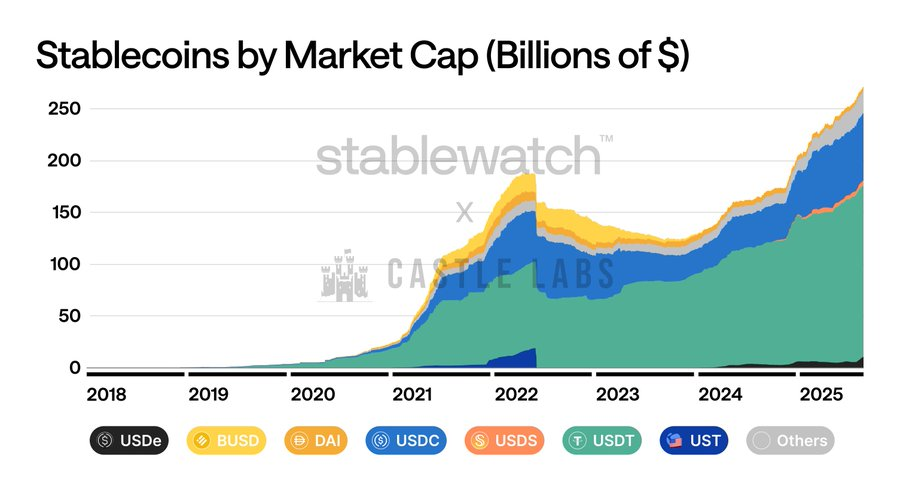
While stablecoins have gained strong adoption, especially in countries plagued by local currency inflation, they still rely on general-purpose blockchains that are not specifically designed for these use cases.
There are countless examples of general-purpose blockchains failing to meet the global scalability requirements of stablecoin networks. They were not designed with fee predictability or execution guarantees in mind.
Some examples of these shortcomings include:
Yuga Labs' minting of the "Otherside" NFT resulted in over $200 million in gas fees burned on Ethereum.
Low-fee networks like Solana and Base have MEV and arbitrage opportunities, which stimulate a large amount of transaction spam.
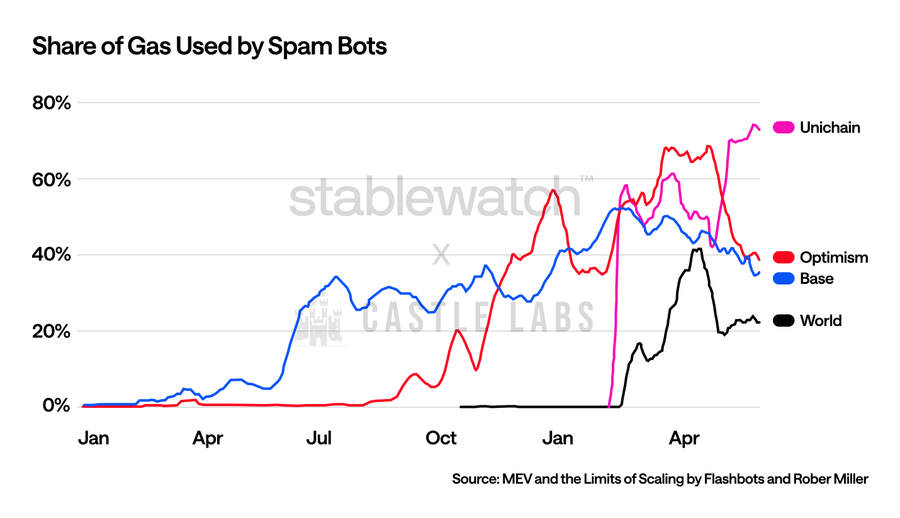
Source: "MEV and the Limits of Scalability" by Flashbots and Rober Miller
This infrastructure gap has given rise to a new category of blockchains: Layer 1 dedicated to stablecoins. Five projects have emerged as major competitors in this space: Plasma was the first to announce the launch of a public chain focused on stablecoin use, supported by leading stablecoin issuer USDT0 and its partner exchange Bitfinex. Stable quickly followed, also backed by USDT0 and Bitfinex, creating a public chain dedicated to USDT. On the other hand, Monad recently made headlines by acquiring stablecoin infrastructure provider Portal Labs, joining the competition. Codex, while not reliant on an issuing institution like Plasma, is primarily funded by Circle and Coinbase, aiming to become a customized layer for USDC payments. However, Circle has also recently announced the creation of its own payment blockchain, Arc. 1Money, founded by former Binance US CEO Brian Shroder, is also positioning itself as a stablecoin-specific payment network.
Requirements for Stablecoin Chains: Global Adoption is the Key Factor
Real-world demand is driving the stablecoin movement forward, especially in countries suffering from inflation. Stablecoin users include: Turkish freelancers looking to protect themselves from 35% inflation of the Turkish lira, Nigerian manufacturers wanting to pay unbanked suppliers, and Filipino families who should be able to receive remittances within seconds without incurring high Western Union fees.
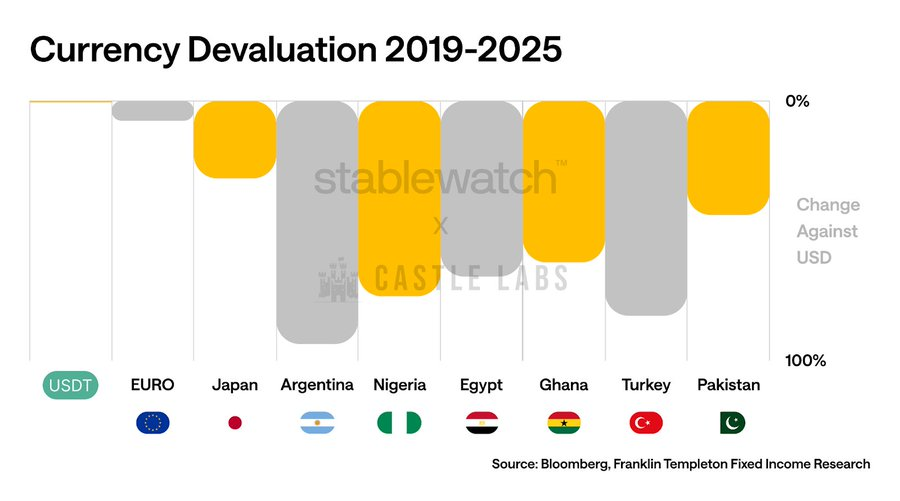
In addition, more enterprises view stablecoins as a means to improve backend efficiency and avoid the high costs of existing payment networks like Mastercard and Visa.
These users are less concerned with ideology and decentralization; they are more focused on solving practical problems. Therefore, successful stablecoin infrastructure must excel in specific criteria that directly impact user experience and economic viability.
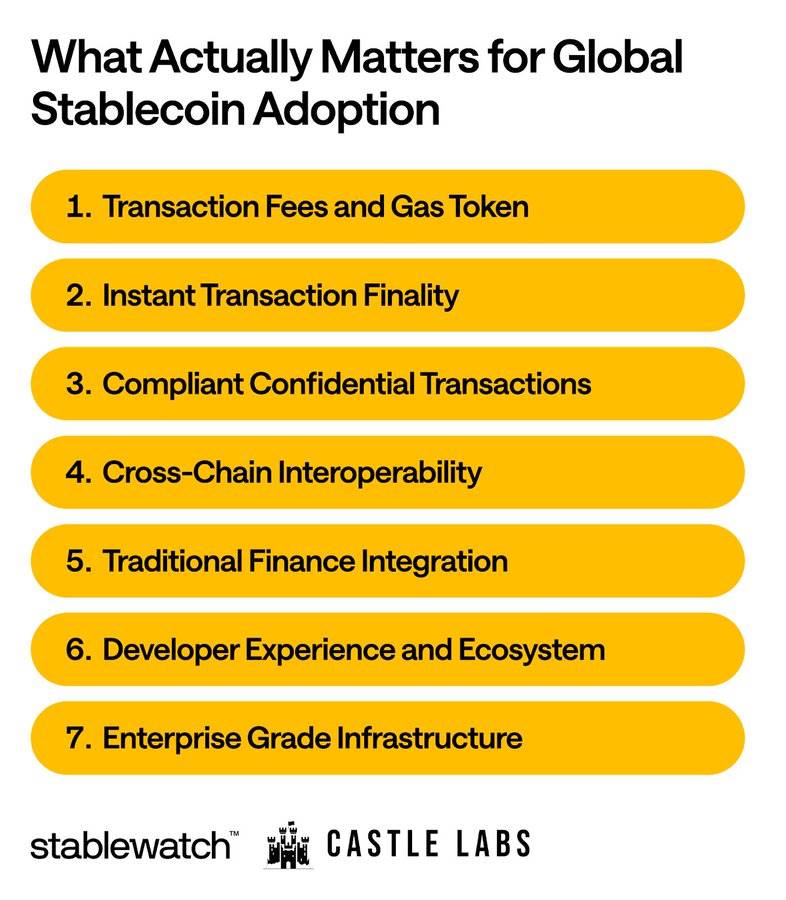
Transaction Fees and Gas Tokens
To bring substantial improvements compared to traditional payment gateways, stablecoins must address some of the inherent frictions of traditional payment methods.
Among these, stablecoin payments aim to eliminate the friction tax associated with traditional remittances. According to the World Bank, remittance users lose an average of 6.35%, with banks charging an average fee of 12.66% for a $200 remittance.
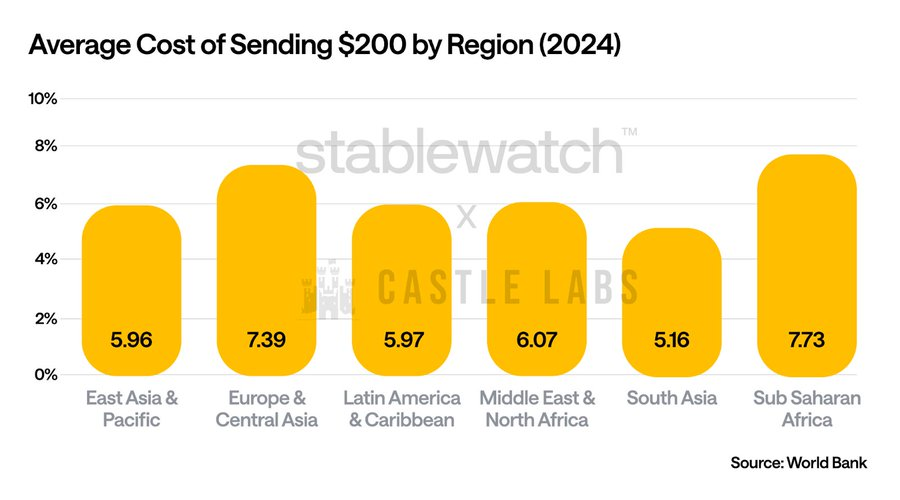
Source: World Bank
True zero-fee transactions make microtransactions possible, removing barriers to adoption for the world's poorest users, who happen to be the ones most in need of this technology.
This is not only about reducing costs but also about enhancing user experience competitiveness:
Users do not have to deal with the implicit provider fees in transactions.
When using stablecoin payments, they do not need to understand dual-token systems or gas economics.
Transfers become as simple as sending a text message.
Instant Transaction Finality
Traditional banks' 3-5 day settlement times create working capital traps, forcing the global economy to rely on implicit credit, which increases costs and inefficiencies associated with each transaction. As business operates globally, payments should follow suit. When a manufacturer in Lagos pays a supplier in Vietnam, the payment should be completed in seconds, not minutes or hours, eliminating any trust guarantees based on the implicit credit system and the need for working capital. Instant finality enables new business models, such as real-time payroll for global remote workers, timely inventory financing, and instant settlement for e-commerce.
Compliance and Confidential Transactions
While this feature may surprise crypto-native users who value transparency at all costs, business payments require complete privacy:
Companies paying employee salaries cannot make their salary information publicly visible.
Supply chain payments need confidentiality to prevent competitors from analyzing proprietary information about business relationships.
Imagine a world where having a public wallet means everyone can track you through your daily payments.
Blockchains that facilitate future payments need to provide users with inherent privacy protections. However, this cannot be complete anonymity like Monero; it should be selective privacy, allowing transparency to comply with global KYC and AML regulations.
Cross-Chain Interoperability
For stablecoins to achieve widespread adoption, they must be able to interoperate across different blockchain networks. Currently, the launch of new networks will continue to impact this fragmentation. Successful stablecoin infrastructure must seamlessly integrate with other blockchains, allowing users to transfer value and access active DeFi ecosystems like Ethereum, Solana, Hyperliquid, Base, and Arbitrum.
Native cross-chain functionality prevents ecosystem lock-in (a common issue in traditional fintech) and liquidity fragmentation, enabling users to access the best applications regardless of which blockchain they are based on.
Integration with Traditional Finance
To make stablecoins the primary means of value transfer and surpass traditional finance, they must seamlessly integrate with existing systems to facilitate this transition. This means direct connections to bank accounts, integration of credit/debit cards, and support for traditional commercial banking functions like ACH, wire transfers, and merchant services. During the transition period, users need to be able to switch seamlessly between the two realms, and the blockchain network must be able to achieve this, providing users with a seamless application experience.
Developer Experience and Ecosystem
Network effects are one of the main driving forces behind application adoption. This requires attracting developers to join your ecosystem and placing the developer user experience at the core of blockchain success. To achieve this, successful platforms must provide:
Excellent developer tools
Comprehensive documentation
Strong ecosystem support
Sufficient liquidity to build stablecoin-centric applications
A strong developer ecosystem will not only attract existing flagship DeFi and payment products to the chain but also has the potential to incentivize the creation of chain-specific new products.
Enterprise-Level Infrastructure
As the use of stablecoins expands beyond the retail sector, enterprises will require customized features, from ensuring transaction throughput to specialized development SDKs. Institutions need reliable performance; this will not change even as they venture into the on-chain world. Consumer-focused blockchains that fail to meet these requirements will lose the opportunity for mass adoption. We have already seen companies like Robinhood choose to build their own blockchains to maintain a controlled environment. Successful stablecoin chains will have these features built-in from day one.
Competitors

Plasma|@PlasmaFDN
Plasma is building a foundational stack for scaling global stablecoin adoption. Their approach is to meet user needs by focusing on USDT payments (the leading stablecoin with over 60% market share). However, Plasma is still attracting a wide range of stablecoin issuers and protocol ecosystems, making diversity its strength. Additionally, Plasma has proactively built a native Bitcoin bridge, aiming to become a central hub for BTC finance supported by stablecoins. This strategy will position Plasma as a hub for the two most widely adopted on-chain asset classes.
Plasma has raised a total of $74 million in multiple funding rounds, including a $24 million seed round and Series A led by Framework Ventures and Bitfinex/USD₮0. Major investors include Bybit and Japan's leading investment bank Nomura, as well as trading and venture capital firms: IMC, Cumberland, Flow Traders, Founders Fund, Katarage, and 6th Man Ventures. Notable angel investors in Plasma include Peter Thiel, Paolo Arduino, Cobie, and Zaheer Ebtikar. Recently, Plasma conducted a public sale of its native token XPL, which was oversubscribed by over 700%, with total oversubscription funds reaching $323.5 million.
Chain Architecture
Plasma's architecture combines its consensus mechanism PlasmaBFT (derived from Fast HotStuff) to handle ordering and final confirmation, along with an execution layer based on Reth to ensure state transitions, transaction execution, and EVM logic. These two components communicate through the Engine API, creating a system that optimizes both performance and compatibility, allowing Plasma to inherit full EVM equivalence without modification.
Plasma BFT supports pipelined operations, allowing new block proposals to begin while the previous block is still being committed. This improves performance and throughput by overlapping block proposal and final confirmation steps.
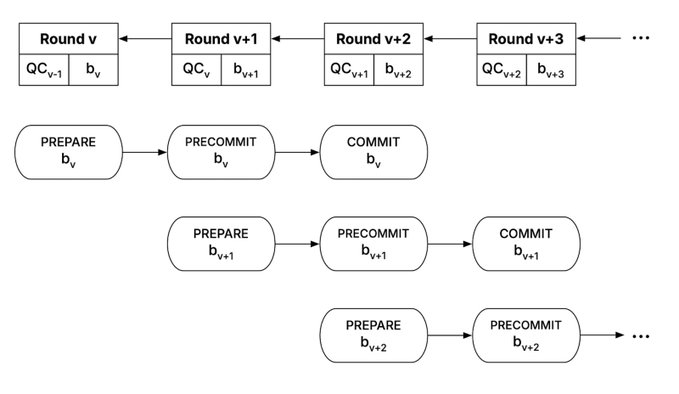
Plasma's proof-of-stake model innovates on traditional methods by reducing rewards for misbehaving validators rather than their collateral. Additionally, validators will not be penalized for liveness failures, and the team is exploring optional non-locked staking, allowing for instant withdrawal of stakes.
Plasma's consensus will follow a phased decentralization approach:
Phase 1
- Trusted Validator Launch: A small group of known validators will protect the network at mainnet launch, allowing for stability and protocol iteration without operational risk.
Phase 2
- Validator Expansion: Expanding the validator set to test horizontal performance under larger committee sizes and validate throughput under additional trusted entity loads.
Phase 3
- Permissionless Participation: Opening validator access to the public, achieving full decentralization with built-in safeguards while maintaining protocol-level security guarantees.
Another core part of Plasma's chain architecture is the native Bitcoin bridge, which allows BTC to be used in smart contracts without relying on custodians, synthetic assets, or isolated wrapped tokens. This is achieved through a synthetic version of an underlying asset called pBTC, inheriting cross-chain interoperability from the LayerZero OFT standard. According to Plasma, the bridge is protected by a network of validators that will decentralize over time, consisting of independent entities, each running their own infrastructure. The signing process involves multi-party computation (MPC) or threshold Schnorr signatures, ensuring that no single validator holds the complete private key.
Plasma is currently in the testnet phase, with a total of 338.47k confirmed transactions from 137,927 addresses.
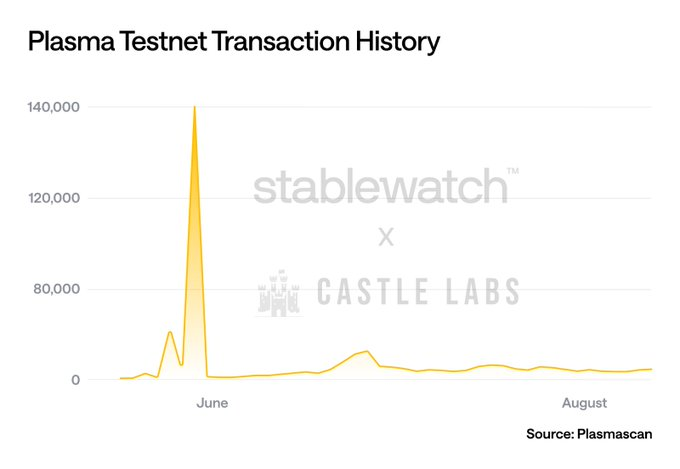
Transaction Fees and Gas Tokens
Plasma provides complete Gas extraction for USDT through its protocol-level payment system. This mechanism sponsors Gas for eligible USDT transfers through lightweight authentication and rate limiting, with funds coming from the XPL quota managed by the protocol. Additionally, users can pay Gas using whitelisted assets like USDT and BTC, with automatic conversion for payments, completely eliminating the need for users to hold native XPL tokens when making payments.
Instant Transaction Finality
Plasma is secured by PlasmaBFT, a high-performance implementation of Fast HotStuff written in Rust. It combines the security of Byzantine Fault Tolerance (BFT) consensus with low-latency finality, achieving sub-second block times for "near-instant settlement." This ensures the high throughput and certainty guarantees required for large-scale stablecoin applications.
Compliance and Confidential Transactions
Plasma is exploring a confidential payment framework that will include secret address transfers based on the recipient's public key, protecting recipient information from public view and allowing only the recipient to see and claim funds. Users will be able to use native mechanisms to transfer payments in and out of confidential streams without the need for new tokens, wrappers, or bridges. Embedded Memos allow optional encrypted metadata to be attached to each transfer. Users can obtain authorization through selective disclosure and verifiable proofs, ensuring complete privacy while maintaining auditability and compliance.
Cross-Chain Interoperability
Plasma is a blockchain focused on USDT, planning to adopt USDT0 instead of issuing native USDT. In addition to integration with LayerZero, Plasma will also launch features like Hyperlane (cross-chain messaging and asset transfer), Relay (cross-chain payment system), and Stargate (cross-chain asset transfer). Plasma is also building a native Bitcoin bridge to enable BTC usage in smart contracts without relying on custodians, synthetic assets, or isolated wrapped tokens.
Integration with Traditional Finance
Plasma will support a wide range of payment partners, including issuing institutions, global fund inflows and outflows, stablecoin coordination, liquidity partners, and risk and compliance tools. The details of announced partnerships are as follows:
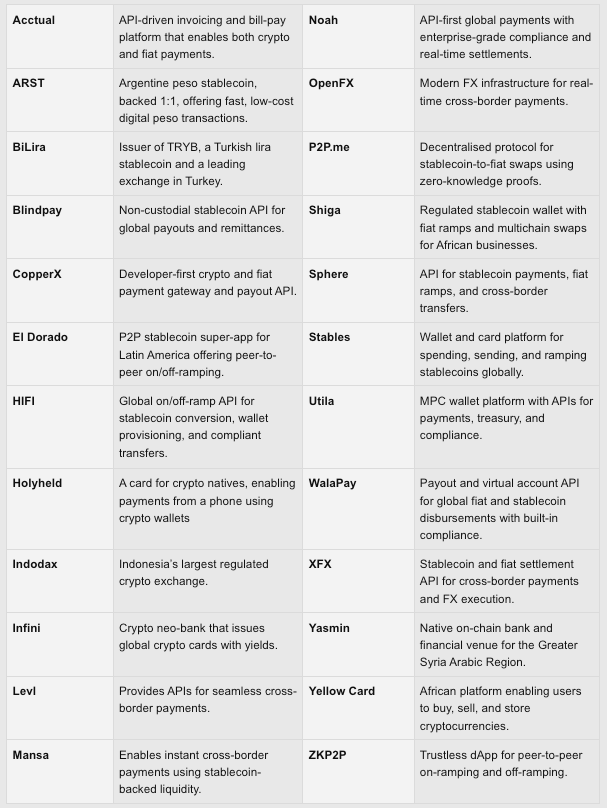
Developer Experience and Appeal
Plasma has gained significant attention even before its testnet launch, integrating multiple key partners and tools. It has already partnered with 24 payment service providers, as well as 5 account abstraction infrastructure/wallet providers (Gelato Relay, Protofire Safe, Thirdweb, Privy, and Turnkey), data analytics platform Dune, four blockchain indexers (Arkham, Goldsky, Quicknode, and Zerion), and oracles like Chainlink and Blocksense. This means that from day one, Plasma will have a large application ecosystem, and most importantly, it will have the infrastructure providers to incentivize user adoption. Additionally, Plasma has conducted a public sale of its native token XPL. To qualify for the sale, potential buyers had to lock stablecoins, resulting in a total locked stablecoin liquidity of up to $1 billion in this public sale. These stablecoins will be converted to USDT0 and issued on Plasma after the mainnet launch. This strategy released a significant amount of liquidity before Plasma's official launch, allowing it to effectively address the cold start problem of new blockchains. Plasma recently announced several heavyweight cryptocurrencies launching on its platform, including Aave, Fluid, Pendle, and Binance Earn, which has already secured over $1 billion in deposits.
Enterprise-Level Infrastructure
Plasma provides comprehensive payment infrastructure designed for seamless business integration, offering developers and merchants a complete toolkit, including APIs, SDKs, point-of-sale modules, and webhook systems. This robust architecture enables enterprises to easily build payment workflows, implement USDT checkout processes, automate payment systems, and embed stablecoin functionality. This allows merchants in both digital and physical commerce to natively accept stablecoin payments, providing instant settlement, significantly reducing costs compared to traditional payment processors, and enjoying unrestricted global access.
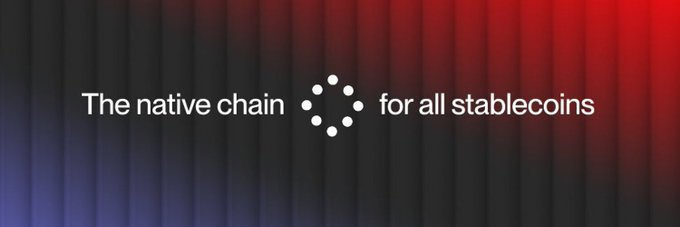
Codex|@codex_pbc
Codex is a Layer 2 blockchain designed specifically for stablecoin institutional payments and programmable financial automation. Its founding team has backgrounds at Meta, Coinbase, and Jane Street, and is supported by leading institutions such as Dragonfly Capital, Coinbase Ventures, Circle Ventures, and others. It has raised $15.8 million to create a secure and compliant environment for high-frequency, business-critical digital currency liquidity.
Most Layer 2 solutions focus on improving the cost and speed of decentralized applications, while Codex is tailored for regulated financial environments, supporting foreign exchange settlements, enterprise APIs, and native stablecoin fee mechanisms.
Chain Architecture
Codex is built on top of the OP Stack, a Rollup framework that is fully compatible with the EVM. This allows Codex to natively support Ethereum smart contracts, wallets, and development tools. Transactions are instantly confirmed on the Codex Layer 2 network and are then submitted to Ethereum Layer 1 for fraud verification and final settlement, typically completed within 5 to 10 minutes.
Unlike independent Layer 1 chains, Codex's security and data integrity are anchored in Ethereum's decentralized validator network. The OP Stack relies on centralized sequencers to quickly order and process transactions on Codex, achieving high throughput and low latency for end users. Once packaged, batch transactions are submitted to Ethereum and undergo fraud proofing, allowing for challenges and preventing any invalid state transitions.
This architecture enables Codex to balance institutional clients' demands for fast, cost-effective settlements with Ethereum's proven security. The modular nature of the OP Stack further allows Codex to adjust its execution, governance, or data availability layers based on changing market and compliance needs, ensuring long-term flexibility and cross-chain interoperability within the broader Ethereum ecosystem.
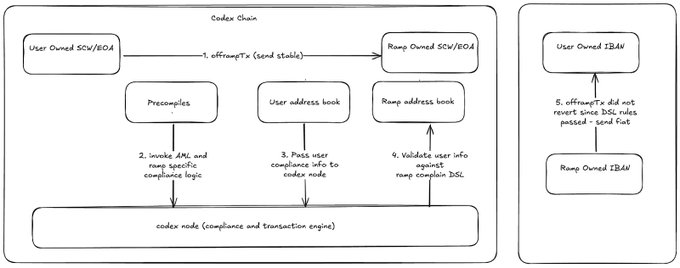
Transaction Fees and Gas Tokens
Codex supports transaction fees paid in USDC, providing deterministic pricing and eliminating the need for volatile gas tokens. This approach simplifies accounting and enhances institutional usability. Gas tokens priced in stablecoins also support enterprise-level reporting and legal audits, which differs from many other blockchains where gas token price fluctuations create uncertainty, forcing compliance teams to hedge.
Instant Transaction Finality
As a Layer 2 blockchain, Codex offers users fast settlements, with most transactions achieving final confirmation within seconds on Codex. However, irreversible finality is only achieved once these transactions are published and confirmed on Ethereum Layer 1, typically taking 5-10 minutes. This structure allows institutions to choose their own risk management strategies: for speed, they can settle on Layer 2; for absolute certainty, they can wait for Layer 1 finality. This Layer 2/Layer 1 model is core to Codex's ability to provide users with fast payment settlements and high transaction throughput while still inheriting Ethereum's robust security guarantees.
Compliance and Confidential Transactions
Codex is currently publicly accessible by default and plans to introduce a compliance privacy layer based on zero-knowledge proofs. Access is managed through KYC onboarding and infrastructure layer controls. If Codex can achieve its zero-knowledge proof compliance roadmap, it may be the first to launch a regulatory-grade privacy solution without compromising enterprise auditing or operational oversight. This is a key challenge, as most enterprises still struggle to balance confidentiality and regulation.
Cross-Chain Interoperability
Codex is EVM-compatible and supports the issuance of native USDC without the need for bridging. Its architecture reduces systemic risks associated with stablecoin transfers, but bridging risks may still exist for non-USDC assets.
Integration with Traditional Finance
Codex is deeply embedded in the institutional stablecoin ecosystem. It supports fiat on/off ramps, foreign exchange conversions, and T+0 settlements, backed by partners like Circle and Coinbase. These integrations enable Codex to support high-throughput cross-border capital flows, B2B financial operations, and direct fiat connections, making it attractive to banks, payment networks, and fintech platforms. The layering of these on/off ramps, foreign exchange channels, and KYC certification pathways narrows the gap between on-chain programmable finance and the reality of global B2B capital flows, positioning Codex as an ideal settlement network for institutions seeking more DeFi public channels.
Developer Experience and Ecosystem
Codex stands out not only through EVM compatibility but also by providing specialized enterprise SDKs, wallet-as-a-service integrations, and compliant APIs for automating large-scale stablecoin flows. Codex's technical and compliance composability offers enterprise developers a one-stop path to integrate programmable currency with traditional infrastructure without sacrificing the audit trails required in real-world finance.
Enterprise-Level Infrastructure
Codex currently does not offer enterprise-specific service level agreements or dedicated block space allocations, but it provides a secure, audited rollup infrastructure and compliance solutions for institutional use cases.
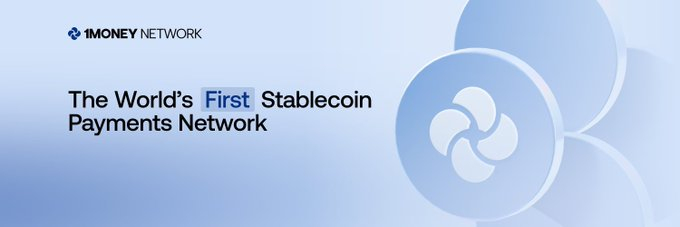
1Money|@1MoneyNetwork
1Money is the next-generation Layer 1 payment network designed for stablecoin transactions. Founded by Brian Shroder (former CEO of Binance.US) and supported by leading fintech and cryptocurrency investors such as F-Prime Capital, Galaxy Ventures, and Hack VC, 1Money raised $20 million in seed funding to launch the first stablecoin-native payment chain. 1Money's mission is to provide the fastest, safest, and most compliant global digital payment platform. By focusing on stablecoin payments rather than general blockchain applications, 1Money aims to eliminate the technical and regulatory barriers that hinder stablecoin use in cross-border trade, remittances, and financial inclusion.
To support this mission, 1Money's architecture significantly differs from traditional Layer 1 designs.
Chain Architecture
At the core of 1Money is its patent-pending Byzantine Consistent Broadcast (BCB) protocol, which replaces traditional block-based processing. The BCB protocol achieves consensus through transaction-level broadcasting and verification, eliminating the batch processing delays of traditional blockchains. This enables parallel transaction processing, providing ultra-fast and irreversible settlements while completely eliminating the risk of chain reorganization. This parallel, blockless structure can process over 250,000 transactions per second, ensuring sub-second settlements with linear capacity growth as the number of nodes increases.
Security is maintained through a permissioned set of validators, with each participant undergoing rigorous KYC and AML procedures. This model significantly reduces risks associated with double spending, MEV, and smart contract vulnerabilities. The network does not support smart contracts at all, eliminating common sources of vulnerabilities, and processes each transaction independently without relying on block production, which can cause delays.
Fees are charged directly in supported stablecoins and are based on a fixed pricing model designed for operational predictability. Protocol-level compliance features include automatic sanctions enforcement and reporting, while support for multiple stablecoin assets positions 1Money as a strong competitor for the core infrastructure of global payment systems.
Transaction Fees and Gas Tokens
1Money charges fixed and low fees in stablecoins, without using a native token. It avoids volatility-based pricing and aims to subsidize fees through third-party partnerships. This non-speculative model aligns with corporate accounting expectations, rejecting the financialization of block space and attracting operators seeking clarity rather than complexity. This model is uncommon among other Layer 1 platforms, where native tokens typically serve dual roles as incentives and speculative assets. By completely eliminating friction caused by tokens, 1Money directly appeals to CFOs and financial managers who prioritize operational clarity over crypto-native complexity.
Instant Transaction Finality
Sub-second transaction-level finality is achieved through the BCB protocol. Each transaction is independently verified and broadcasted, avoiding batch processing delays. The blockless model allows for deterministic, irreversible settlements and can achieve horizontal scalability with validator participation. This makes 1Money one of the few blockchains capable of providing deterministic sub-second settlements without relying on probabilistic finality, representing a technological leap with significant similarities to high-frequency payment rails. The ongoing patent application for BCB further confirms this, marking its reliable innovation beyond marketing.
Compliance and Confidential Transactions
1Money prioritizes compliance over anonymity. All accounts must undergo a complete KYC/AML onboarding process, and each transaction is visible to the network's authorized validators. 1Money does not pursue crypto privacy tools but offers pseudonymous services under regulatory scrutiny, making it well-suited for regulated entities, though not ideal for privacy-focused users. This deliberate prioritization transforms privacy from a technical feature into a regulated service: transaction metadata is kept confidential from the public but fully auditable by designated authorities, setting a new compliance benchmark for enterprise chains and outlining a potential blueprint for global payment regulators.
Cross-Chain Interoperability
1Money is designed for financial interoperability, seamlessly integrating with traditional financial institutions and other Layer 1 chains. Through atomic messaging and an API-based architecture, it supports stablecoin transfers across networks without relying on smart contracts or liquidity bridges. Its infrastructure is intended to serve as a payment backbone rather than a composable layer. By avoiding general composability, 1Money reduces the risks of security and liquidity fragmentation—issues that have plagued bridge-centric DeFi protocols—focusing instead on reliability rather than coverage.
Integration with Traditional Finance
1Money provides digital accounts, deposit and withdrawal channels, debit card programs, and merchant payment APIs. Its focus includes remittances, financial inclusion, and B2B settlements, aiming to align with the compliance and operational standards of corporate partners. By abstracting the complexities of cryptocurrency, 1Money allows businesses in emerging markets to onboard using familiar processes, enabling compliance teams and non-technical operators to easily engage with the network—something that is not achievable in Layer 1 networks primarily optimized for DeFi architectures.
Developer Experience and Ecosystem
Unlike programmable chains, 1Money does not support smart contracts. Instead, it offers a robust set of APIs tailored for financial service providers, banks, and fintech developers. The network trades off composability for predictability, attracting developers building regulated financial infrastructure rather than consumer-facing dApps. 1Money's ecosystem strategy resembles that of traditional enterprise software platforms, prioritizing onboarding processes, auditability, and API reliability.
Enterprise-Level Infrastructure
1Money's infrastructure is optimized for compliance, with validator participation limited to entities that have undergone formal onboarding and governance reviews. This ensures that the reliability and auditability of transactions are maintained at the protocol level, placing operational trust on top of a decentralized foundation. This stance is a conscious trade-off: by strengthening validator gatekeeping and service assurance, 1Money bets that the next era of stablecoin settlements will depend on trust, compliance, and uptime rather than maximizing permissionlessness.

Arc|@Arc
Arc is a Layer 1 blockchain created by Circle specifically for stablecoin finance and programmable currency. Unlike other competitors built from scratch, Arc leverages Circle's existing advantages as the issuer of USDC, which has a circulation of over $68 billion. This allows Arc to immediately access stablecoin liquidity and establish institutional partnerships with other blockchains, which other chains must work hard to build. Circle's regulatory status and compliance infrastructure make Arc the most integrated solution in the stablecoin infrastructure space.
Circle has raised over $1 billion through multiple funding rounds from institutional investors such as Goldman Sachs, BlackRock, Fidelity, and Digital Currency Group. Circle recently went public on the New York Stock Exchange under the ticker symbol CRCL, allowing for additional funding from the public market.
Chain Architecture
Arc is built on the Malachite consensus engine, a high-performance implementation of the Tendermint BFT protocol. The network employs a permissioned proof-of-authority (PoA) validator set, composed of mature and geographically distributed institutions that meet strict operational and regulatory standards. This design prioritizes institutional requirements and regulatory compliance over maximum decentralization.
The architecture provides deterministic finality and is fully EVM-compatible, allowing developers to use familiar Ethereum tools while benefiting from sub-second settlement guarantees. Arc achieves approximately 3,000 TPS throughput through 20 geographically distributed validators, with finality completed within 350 milliseconds. In an optimized configuration with four validators, the network can exceed 10,000 TPS, with finality under 100 milliseconds.
The roadmap includes multi-proposer support, which could increase throughput by about ten times, and optional low-fault tolerance configurations that could reduce latency by about 30%. The modular architecture supports future integration of advanced privacy technologies without requiring fundamental protocol changes.
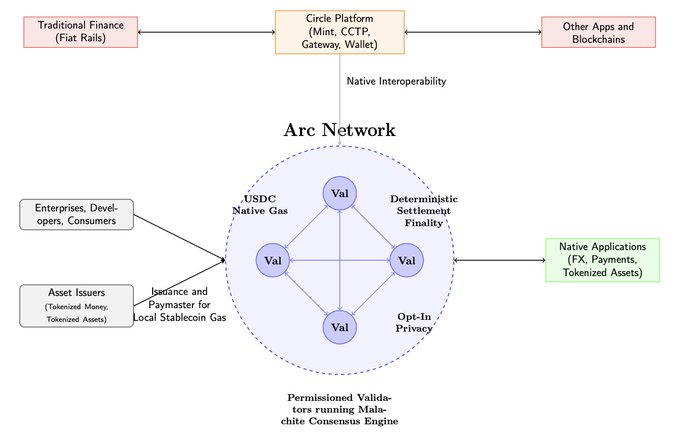
Transaction Fees and Gas Tokens
Arc uses USDC as its native gas token, eliminating fee volatility and simplifying accounting for enterprises. The network implements an enhanced EIP-1559 mechanism, using an exponentially weighted moving average to smooth fee fluctuations and provide predictable transaction costs. Through dedicated payment master integration, users can pay fees using other local stablecoins and tokenized currencies, eliminating the need to hold volatile native tokens.
Transaction fees will be directly deposited into the on-chain treasury (Arc Treasury) upon Arc's launch to support the network's long-term development. This approach provides enterprises with dollar-denominated transaction costs, enabling predictable financial planning and operational budgeting.
Instant Transaction Finality
Arc provides deterministic finality in under 350 milliseconds through its Malachite consensus engine. Transactions on Arc are either unconfirmed or 100% final and irreversible—without a probabilistic settlement phase. Once a block receives commitments from more than two-thirds of validators through multiple rounds of voting, it immediately becomes the final block, providing the settlement certainty required for institutional financial workflows.
Compliance and Confidential Transactions
Arc's privacy roadmap begins with confidential transfers aimed at protecting transaction amounts while maintaining address visibility to ensure compliance. This solution uses EVM precompiled contracts connected to a cryptographic backend and leverages Trusted Execution Environments (TEEs) to achieve high-performance, auditable privacy.
The privacy model supports institutional compliance through "view keys," which provide authorized parties with read-only access to specific transaction data. This allows for selective disclosure of information to auditors and regulators while maintaining business confidentiality. The modular architecture allows for future integration of advanced privacy technologies, including Multi-Party Computation (MPC), Fully Homomorphic Encryption (FHE), and zero-knowledge proofs.
Cross-Chain Interoperability
Arc offers comprehensive traditional financial integration through Circle's mature platform products. Native integrations include Circle's Mint service, which allows for the issuance of USDC directly from fiat bank deposits, seamlessly bridging traditional finance without credit requirements. The network supports direct bank account connections, enterprise-level compliance tools, and traditional commercial banking functions.
Circle's regulatory relationships and compliance infrastructure provide Arc with institutional-level connections to traditional financial systems. This includes support for regulated financial services, institutional custody solutions, and direct integration with existing enterprise financial workflows through Circle's mature partner ecosystem.
Integration with Traditional Finance
Arc provides enterprise-level developer tools, including dedicated SDKs, comprehensive APIs, and native payment modules for invoice-linked payments, refund agreements, and smart financial agents. The platform maintains EVM compatibility while offering financial-specific primitives, lowering the barrier to building compliant financial applications.
Circle's mature ecosystem enables Arc to immediately access institutional relationships, regulatory frameworks, and established infrastructure. The network natively supports Circle's product suite at launch, including USDC, EURC, USYC (tokenized money market funds), and comprehensive payment infrastructure, allowing developers to leverage proven financial primitives from the outset.
Developer Experience and Appeal
Arc will launch proven financial primitives. It natively supports USDC, EURC, and USYC (Circle's tokenized money market fund), providing developers with verified and regulated building blocks for financial applications. The dedicated SDK supports complex workflows, including invoice-linked payments, automated refund agreements, and programmable fund management.
EVM compatibility ensures that developers can utilize existing Ethereum tools while accessing Arc's financial-specific features. This familiar development environment, combined with professional financial primitives, significantly lowers the technical barrier to building enterprise-grade financial applications.
Circle's ecosystem provides instant access to institutional clients, regulatory frameworks, and mature use cases. Arc is not building a developer community from scratch but inherits Circle's established customer relationships and mature market demand.
Enterprise-Level Infrastructure
Arc aims to create institutional-grade infrastructure with permissioned validators, performance guarantees, and comprehensive compliance features. The validator model ensures operational resilience and regulatory compliance, while the modular architecture supports customization based on specific enterprise needs.
The network provides native support for complex financial workflows, including programmable foreign exchange engines, tokenized asset issuance, and automated fund management. Arc's roadmap includes transitioning to a permissioned Proof-of-Stake to achieve broader validator decentralization while maintaining institutional-grade security and compliance standards.

Monad|@monad
Monad represents a different category compared to the other chains discussed earlier, strategically pivoting to leverage the growth opportunities presented by stablecoin adoption. Therefore, Monad did not build stablecoin infrastructure from scratch but acquired Portal Labs to integrate comprehensive payment capabilities while maintaining its performance advantages. Portal Labs is a stablecoin finance developer platform that allows businesses to create wallets, transfer stablecoins, and scale on-chain operations through SDKs and dedicated APIs. This acquisition marks a first for the blockchain foundation and is likely to introduce an exciting new competitor in the stablecoin space.
Monad has raised a total of $248 million across three funding rounds, with the latest Series A round completed in May 2024, valuing the company at $3 billion. Major investors include cryptocurrency venture capital giant Paradigm, which led the Series A round, and Dragonfly, which led the seed round. Other investors include Coinbase Ventures, GSR Ventures, Wintermute Ventures, and OKX Ventures. Notable angel investors include Naval Ravikant, Cobie, and Hasu.
Chain Architecture
The Monad team has nearly rebuilt every component of their client from the ground up to push the boundaries of scalability and decentralization. Monad claims that these innovations will enable them to achieve a performance metric of 10,000 TPS, with a block frequency of 500 milliseconds and a final confirmation time of 1 second. This would make them one of the highest-performing EVM-based Layer 1s. Monad achieved this feat on its testnet, peaking at 10,832 TPS on April 17.
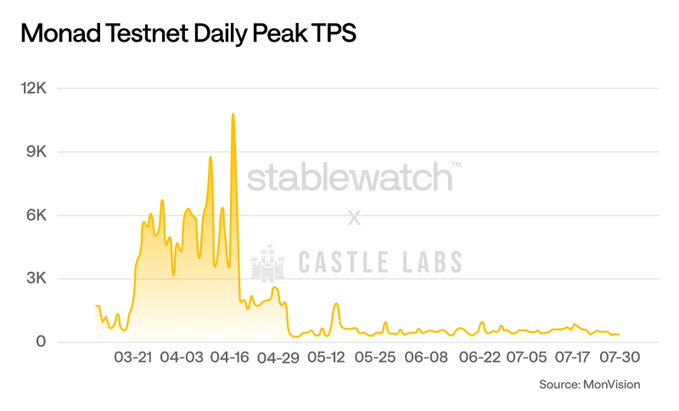
Monad addresses speed issues by running multiple processes simultaneously (rather than executing all operations sequentially). It employs the MonadBFT consensus mechanism (based on the mature HotStuff algorithm), capable of handling malicious actors and processing transactions in a pipelined batch manner. This allows Monad to process different transactions concurrently in a parallel pipeline, significantly increasing throughput.
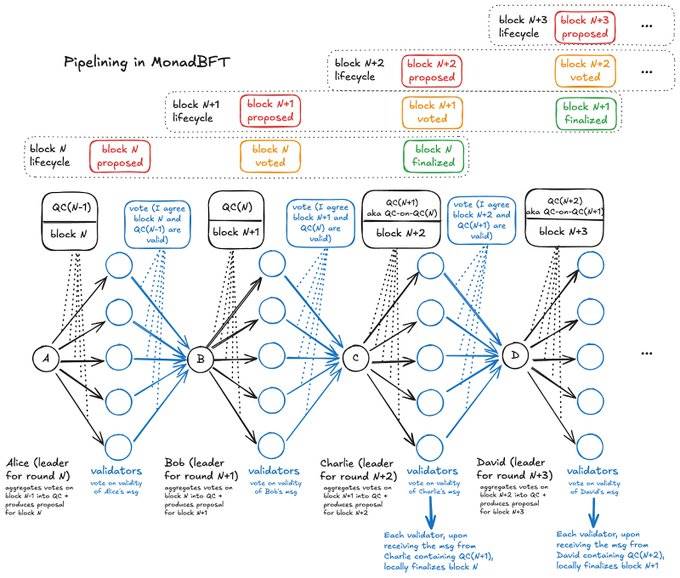
In MonadBFT, the path from proposal to final confirmation for block N ideally follows linear communication, typically adhering to a "fan-out, fan-in" model. The leader sends messages directly to validators; validators send messages directly to the next leader.
Monad uses two additional technologies to maximize speed: MonadDB, a custom database optimized for blockchain data storage, and RaptorCast, a method for propagating new blocks across the network using erasure coding and a dual-layer broadcasting system. This effectively utilizes the upload capacity of each validator on the internet, minimizing the time required for everyone to receive new blocks.
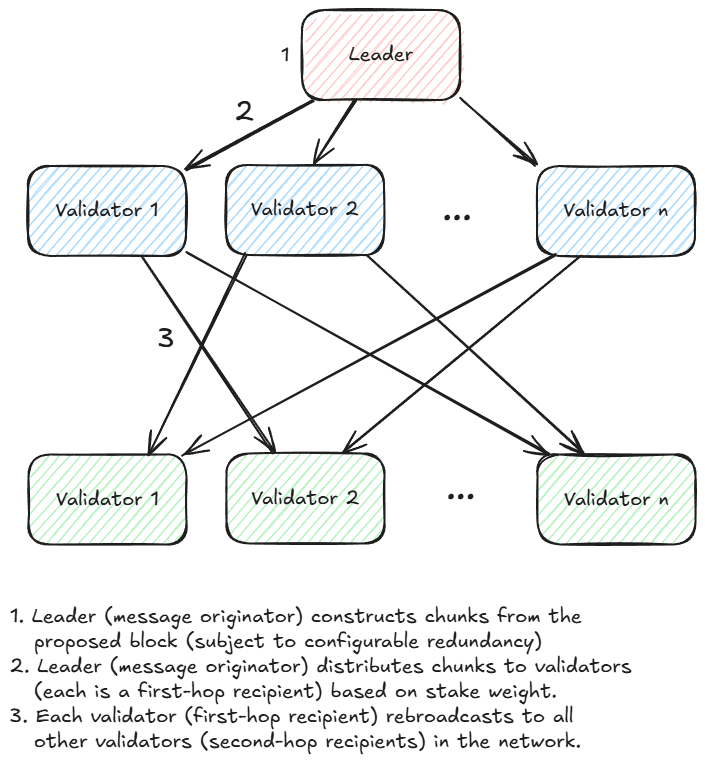
RaptorCast is used to send erasure-coded data blocks from the leader to each validator.
Transaction Fees and Gas Tokens
Monad aims to achieve "near-zero gas fees" and is compatible with EIP-1559. While this represents an improvement over traditional blockchains, Monad still retains traditional gas economics, requiring users to hold and manage native tokens to pay gas fees. This approach is cost-competitive while avoiding the friction of users holding volatile native tokens.
Instant Transaction Finality
Monad is committed to providing exceptional finality performance, achieving 1-second single-slot finality and 1-second block times. This means transactions can be irreversible within one second, making it an optimal choice for real-time payment applications.
Compliance and Confidential Transactions
As a general-purpose chain, Monad does not include privacy features itself but relies on its general EVM capabilities to provide a foundation for potential application-layer solutions.
Cross-Chain Interoperability
The acquisition of Portal provides Monad's stablecoin users with significant built-in features, including cross-chain interoperability. Portal enables customers to easily perform cross-chain exchanges across more than 100 supported blockchains. Additionally, it supports multiple interoperability partners, including Chainlink CCIP (which allows developers to build secure cross-chain applications that can transfer tokens, send messages, and initiate operations across blockchains), Garden (cross-chain Bitcoin exchange), Hyperlane (cross-chain messaging and asset transfer), LayerZero (cross-chain messaging), Polymer (cross-chain operation proofs via cross-chain Merkle proofs), and Wormhole (cross-chain messaging protocol).
Integration with Traditional Finance
Monad's payment ecosystem includes three projects that integrate the chain with TradFi:
Agora, a stablecoin issuer that facilitates deposit/withdrawal channels.
DAU Cards, which issue crypto-supported debit cards.
Fizen, which provides a crypto payment gateway along with deposit/withdrawal channels, enabling businesses to accept crypto payments.
Furthermore, the acquisition of Portal Labs also provides Monad with a dedicated stablecoin payment infrastructure provider, including embedded wallets with TSS MPC security and easy-to-integrate APIs/SDKs. Other key features of Portal products include gas sponsorship, batch transactions, and enterprise-level security assurances.
Developer Experience and Appeal
Monad demonstrates a strong commitment to building a developer ecosystem through founder residency programs, Madness competitions, hackathons, and the Mach Accelerator program. These initiatives not only provide funding but also offer guidance and ecosystem connections. Additionally, the foundation is actively engaged in business development, with over 273 projects already committed to launching on the Monad mainnet. These projects span categories such as AI, gaming, DeFi, DePIN, governance, NFTs, payments, prediction markets, RWA, and social. For a complete list, visit the Monad ecosystem directory: https://www.monad.xyz/ecosystem
Enterprise-Level Infrastructure
Reportedly, Monad's high performance (10,000 TPS, 1-second final confirmation) provides the predictable service levels required by enterprises. However, aside from the Portal acquisition, its specialized stablecoin enterprise features have not been detailed.

Stable|@Stable
Stable addresses the core issues of stablecoin infrastructure: USDT has a circulation of $160 billion and over 500 million users, generating billions of dollars in transfers daily, yet operates without a blockchain specifically optimized for it. Unlike general-purpose blockchains that treat stablecoins as other assets, every component of the Stable protocol is meticulously designed to minimize friction in USDT transfers and provide a streamlined, high-performance, and tailored environment.
Stable recently announced the completion of a $28 million seed round, led by Bitfinex, USDT0, and Hack VC. Other participants include Franklin Templeton, Castle Island Ventures, E-girl Capital, ByBit Mirana, Susquehanna International Group, Nascent, Blue Pool Capital, BTSE, and KuCoin Ventures. Notable advisors include Paolo Arduino, Nathan McCauley, Brian Johnson, and Gabriel Abed.
Chain Architecture
The network is a Layer 1 using StableBFT, which is based on CometBFT (a mature branch of Tendermint), providing deterministic finality and fault tolerance for up to one-third of validators. The platform achieves sub-second block times and finality, ensuring transactions are completed quickly to support real-time settlement. Through the Stable SDK, StableBFT will be able to communicate with the Stable EVM (an Ethereum-compatible execution layer) via a set of precompiled contracts. These precompiled contracts will expose the native StableSDK module functionalities to EVM smart contracts, allowing them to interact securely and atomically with core chain logic.
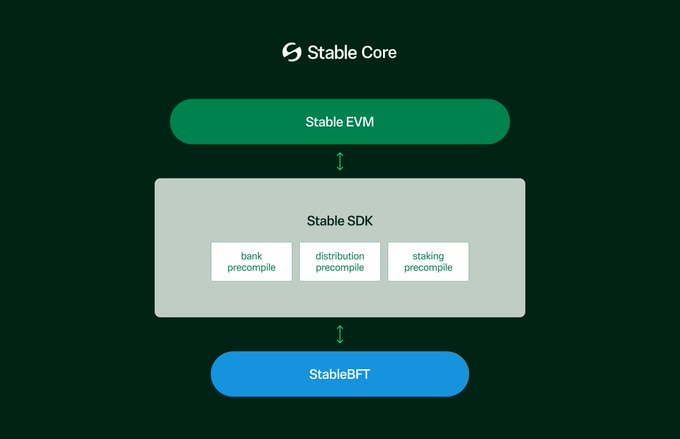
The technical roadmap reveals ambitious performance goals through a three-phase optimization strategy, with Phase 1 being the current Stable implementation:
Phase 2
Introduce optimistic parallel execution (achieving a 2x throughput increase)
Optimize the state database using MemDB and VersionDB with memory-mapped storage
USDT transfer aggregator for large-scale transaction processing
Phase 3
Implement advanced consensus through StableBFT built on Autobahn (demonstrating 200,000+ TPS in a controlled environment)
StableVM++ implemented in C++ as an alternative to the Go-based EVM (expected execution performance improvement of 6x)
High-performance RPC architecture supporting over 10,000 TPS with latency under 100 milliseconds
Transaction Fees and Gas Tokens
Stable uses USDT0 as its primary token and implements gasless USDT0 transfers through EIP-7702 and account abstraction features. For non-USDT0 transactions, users pay gas fees using USDT0 tokens, which the packers and payment systems automatically convert into gasUSDT. Users only need to hold USDT0 tokens, and the protocol automatically handles all gas conversions, eliminating the complexity of traditional dual-token systems.
However, peer-to-peer USDT transactions on Stable are completely free, as they leverage the EIP-7702 permission mechanism and account abstraction.
Instant Transaction Finality
Stable will provide sub-second block times and single-slot final confirmation on EVM, uniquely optimized for the scalable issuance, settlement, and management of USDT.
Compliance and Confidential Transactions
Stable's roadmap includes confidential transfer features that utilize zero-knowledge proof (ZK) encryption technology to hide transaction amounts while maintaining the visibility of sender/receiver addresses to ensure compliance. This will provide enterprise-level privacy protection for business payments while still maintaining auditability for KYC and AML.
Cross-Chain Interoperability
The USDT0 token to be used on Stable follows the LayerZero OFT standard, enabling seamless cross-chain transfers of USDT without relying on traditional bridging complexities. This allows it to interoperate directly with other blockchains connected to LayerZero, integrating USDT liquidity across networks. This positions Stable as a central hub for cross-chain USDT activity rather than an isolated network.
Integration with Traditional Finance
Stable has natively implemented TradFi integration. The Stable App offers social login features, providing a familiar user experience for non-cryptocurrency native users. The wallet will directly integrate debit and credit cards, linked to USDT, simplifying everyday payments with stablecoins. Additionally, Stable is developing merchant payment tools that enable businesses to accept USDT directly, avoiding fees from third-party payment platforms.
Developer Experience and Appeal
Stable is committed to simplifying the development of USDT-based applications, providing an SDK tailored specifically for stablecoin-based dApp development. Stable will also offer robust APIs and integration services, allowing Stable's infrastructure to seamlessly integrate into existing enterprise systems. Precompiled contract interfaces will facilitate seamless interaction between EVM contracts and Stable SDK modules, simplifying complex cross-module transactions. The close integration with the Tether ecosystem creates unique opportunities for developers focused on USDT.
Enterprise-Level Infrastructure
Stable's guaranteed block space model provides dedicated transaction capacity for enterprises through validator-level customization. Validators will extract guaranteed transactions from a dedicated memory pool, prioritizing these transactions, which are isolated from public traffic. Dedicated RPC nodes route transactions through isolated RPC endpoints, reducing contention and achieving stable throughput, facilitated by a set of guaranteed block space APIs. Through this framework, Stable aims to ensure that critical business operations maintain stable performance even during network congestion. This brings a comprehensive institutional infrastructure designed specifically for enterprise risk management.
Comparison Summary Table

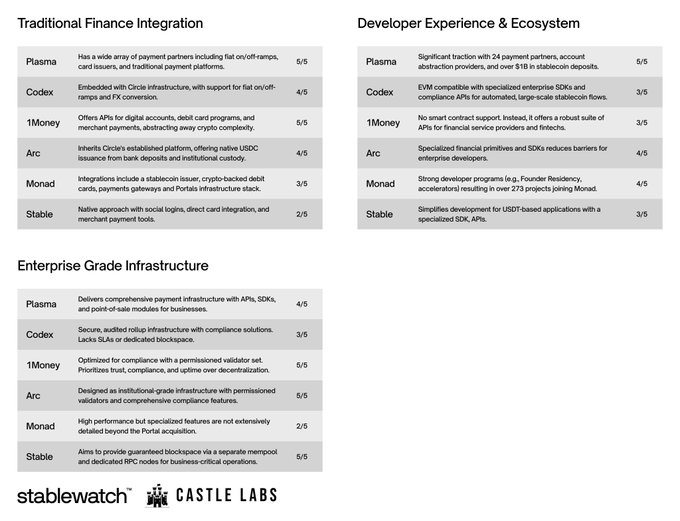
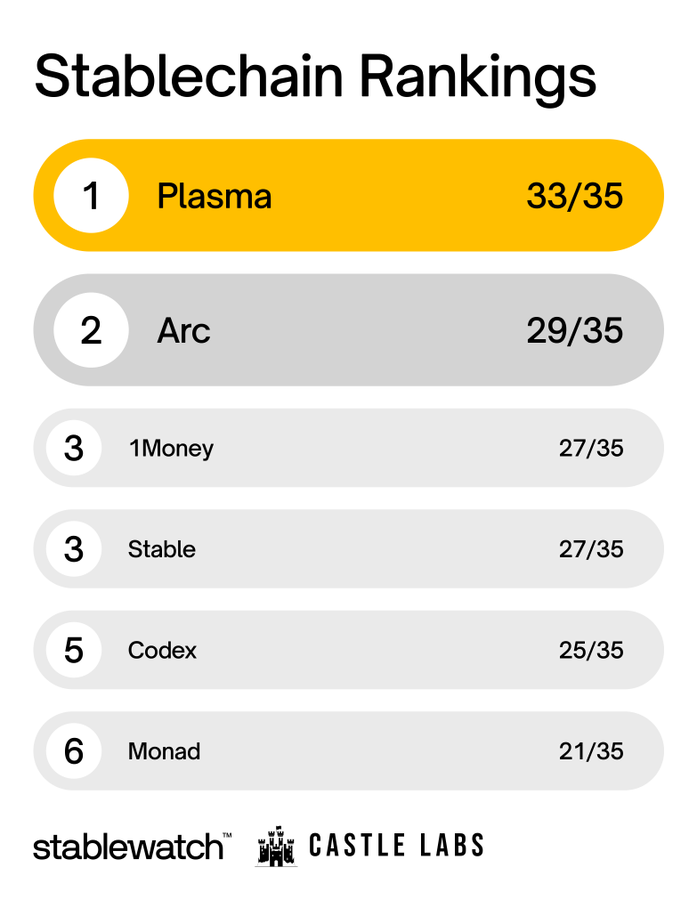
免责声明:本文章仅代表作者个人观点,不代表本平台的立场和观点。本文章仅供信息分享,不构成对任何人的任何投资建议。用户与作者之间的任何争议,与本平台无关。如网页中刊载的文章或图片涉及侵权,请提供相关的权利证明和身份证明发送邮件到support@aicoin.com,本平台相关工作人员将会进行核查。




